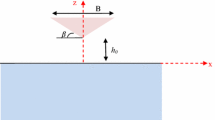Abstract
The flow generated during the early stage of the impact of an asymmetric wedge is here investigated, with the help of a conformal-mapping technique. The wedge is assumed to be initially at rest and floating on a still free surface of an inviscid and incompressible liquid. The study is aimed at understanding the main features of the flow that develops in the vicinity of the apex of the wedge. Due to the inviscid-fluid assumption, a velocity (and pressure) singularity takes place at the apex of asymmetric wedges, which is here removed by reintroducing viscous effects, in terms of the shedding of a wake from the apex. In the present numerical approach, the wake is modelled through point vortices, circulations of which are provided via a suitable Kutta condition. Attention being focused at the early stage of the impact, the free surface is kept during the penetration of the body. This allows the use of an asymmetric extension of Sedov's solution to describe the flow field generated by the wedge entry. Changes induced by the vortical flow on the velocity field and on the pressure distribution on the wedge are discussed.
Similar content being viewed by others
References
R. Zhao, O.M. Faltinsen and H.A. Haslum, A simplified nonlinear analysis of a high speed planing craft in calm water. In: N. Baird and A. Jeffs (eds.), Proc. of FAST '97 Conference. London: Baird Publications (1997) pp. 431–438.
B.R. Savander, Planing Hull Hydrodynamics. Ph.D. Thesis, Dept. of Naval Architecture and Marine Engineering, University of Michigan (USA) (1997) 158pp.
L. Xu, A.W. Troesch and W. Vorus, Asymmetric vessel impact and planing hydrodynamics. J. Ship Res. 42 (1998) 187–198.
T. von Kármán, The impact of seaplane floats during landing. NACA TN 321 (1929) 8pp.
H. Wagner, Ñber Stoß und Gleitvorgänge an der Oberfläche von Flüssigkeiten. Z. Angew. Math. Mech. 12 (1932) 192–215.
Z.N. Dobrovol'skaya, On some problems of similarity flow of fluid with a free surface. J. Fluid Mech. 36 (1969) 805–829.
M. Greenhow, Wedge entry into initially calm water. J. Appl. Ocean Res. 9 (1987) 214–233.
R. Zhao and O.M. Faltinsen, Water entry of two-dimensional bodies. J. Fluid Mech. 246 (1993) 593–612.
R. Zhao, O.M. Faltinsen and J. Aarnes, Water entry of arbitrary two-dimensional sections with and without separation. In: E. Rood (ed.), Proc. of 21st Symp. on Naval Hydrodynamics. Washington: National Academy Press (1996) pp. 118–132.
E. Fontaine and R. Cointe, Asymptotic theories of incompressible water entry. In: High Speed Body Motion in Water, AGARD Rep. 827.. Neuilly-sur-Seine: Agard Publishers (1997) pp. 25-1–25-9.
D. Battistin and A. Iafrati, Hydrodynamic loads during water entry of two-dimensional and axisymmetric bodies. J. Fluids Struct. 17 (2003) 643–664.
W. Vorus, A cylinder theory for vessel impact and steady planing resistance. J. Ship Res. 40 (1996) 89–106.
P.R. Garabedian, Oblique water entry of a wedge. Comm. Pure Appl. Math. 6 (1953) 157–165.
S.F. Borg, Some contributions to the wedge-water entry problem. J. Eng. Mech. Div., Proc. the Am. Soc. Civil Eng. 83 (1957) 1–28.
Y. Toyama, Two-dimensional water impact of unsymmetrical bodies. J. Soc. Naval Arch. Japan 173 (1993) 285–291 (in Japanese).
Y.M. Scolan, E. Coche, T. Coudray and E. Fontaine, Etude analytique et numérique de l'impact hydrodynamique sur des carénes dissimétriques. In: B. Molin (ed.), Proc. of the 7th Journees de l'Hydrodynamique. Marseille: Groupe ESIM (1999) pp. 151–164.
A. Iafrati, Hydrodynamics of asymmetric wedges impacting the free surface. In: E. Oñate (ed.), Proc. of the ECCOMAS Conference. Barcelona: CIMNE (2000) (on CD-rom)
B.S. Chekin, The entry of a wedge into an incompressible fluid. Prikl. Matem. Mekhan. 53 (1989) 396–404.
N. de Divitiis and L.M. de Socio, Impact of floats on water, J. Fluid Mech. 471 (2002) 365–379.
L. Xu, A Theory for Asymmetrical Vessel Impact and Steady Planing. Ph.D. Thesis, Dept. of Naval Architecture and Marine Engineering, University of Michigan (USA) (1998) 128 pp.
C. Judge, A.W. Troesch and M. Perlin, Initial water impact at oblique angles. Accepted for publication in J. Engng. Math. (2003).
G. Riccardi, A. Iafrati and R. Piva, Vorticity shedding from a lentil-shaped body at large incidence in uniform Meccanica 29 (1994) 159–173.
L.I. Sedov, Floating wedge impact. Tr. Tsentr. Aerodin. Inst. 152 (1935) 27–31.
H. Kober, Dictionary of Conformal Representations. Dover New York (1952) 208 pp.
M. Kiya and M. Arie, A contribution to an inviscid vortex-shedding model for an inclined plate in uniform flow. J. Fluid Mech. 82 (1977) 223–240.
Author information
Authors and Affiliations
Rights and permissions
About this article
Cite this article
Riccardi, G., Iafrati, A. Water impact of an asymmetric floating wedge. Journal of Engineering Mathematics 49, 19–39 (2004). https://doi.org/10.1023/B:ENGI.0000014885.89822.f5
Issue Date:
DOI: https://doi.org/10.1023/B:ENGI.0000014885.89822.f5




